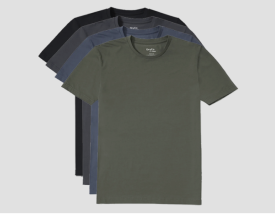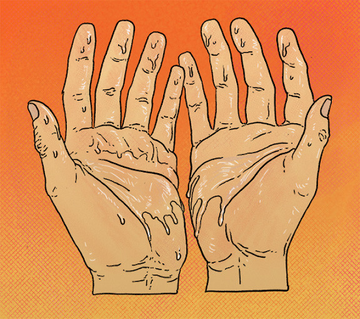Determining how severe one’s hyperhidrosis is can be challenging, especially if a patient tries to do so on their own. However, there is a system out there that eliminates the guessing games: the Hyperhidrosis Disease Severity Scale. The scale serves as a guide to provide doctors and patients with a reference for what is mild, moderate and severe hyperhidrosis. This post will take a look at this scale and how it can be applied for the purpose of finding the most effective treatment.
A Look at the Hyperhidrosis Disease Severity Scale
The Hyperhidrosis disease severity scale can assume one of two forms: a self-assessment or a visual guide. A doctor may use one or both forms to make a diagnosis (in addition to physical examination).
Both scales hint at different ways that excessive sweating affects a sufferer.
The self-assessment is more introspective and qualitative in nature, asking patients to rank how much they feel excessive sweating affects their daily life. The visual guide, on the other hand, is more definitive and quantitative in nature, serving as a reference as to how much they sweat.
The Hyperhidrosis Disease Severity Scale as a Self-Assessment
The self-assessment form of the scale poses a question (there are four questions in total) on how badly hyperhidrosis impacts a person’s daily routine. Each question corresponds with a score of 1-4, 1 being the mildest and 4 being the most extreme.
The self-assessment looks like:

As you may have noticed, each question is essentially a variation of the same core question - how tolerable is your sweating and frequently does it interfere with life. The assessment is quite simple. After reading each question, the patient will then circle one of the four questions/scores that best describes their hyperhidrosis.
Patients with severe (3) or extreme (4) hyperhidrosis probably won’t need to think too hard about how bad their sweating is because it’s obvious. Mild (1) and moderate (2) cases may be trickier to identify because a patient may feel that their excessive sweating is subjective, and only a problem if they allow it to be.
The Hyperhidrosis Disease Severity Scale as a Visual Guide
While the self-assessment identifies how severely hyperhidrosis affects their daily routine, the visual guide identifies how severe hyperhidrosis actually looks and feels. In other words, it attempts to identify the amount of sweating that occurs in an affected region.
Here’s a look at this scale:

In a sense, it works like the self-assessment in that it requires patients to reflect on how much they typically sweat from an affected region. The difference here though, is that visual scale provides a more immediate reference of how bad one’s excessive sweating is. The self-assessment, on the other hand, requires a patient to think about how excessive sweating impacts their jobs, relationships, and hobbies.
The visual guide requires patients to observe how much sweat comes from an affected part. With that said, a patient can use the visual guide in real-time, by reviewing the chart while they have an active episode of sweating. One limitation of the visual guide, however, is that there is no reference for people with craniofacial hyperhidrosis (excessive sweating of the face, head and scalp).
Why Does a Hyperhidrosis Disease Severity Scale Even Matter?
The purpose of filling out or reviewing the scale is to determine whether you need hyperhidrosis treatment or not, and to some extent, what kind of treatment. With a diagnosis of hyperhidrosis severity, a doctor can decide what treatment protocol may work best for you, whether it means relying on one or more methods.
The mildest forms of excessive sweating may require little (if any) treatment at all. A change in diet and the use of sweat-resistant/moisture-wicking fabrics may do wonders for you. Moderate treatments may require the use of prescription-strength, aluminum-based antiperspirant, anticholinergics (in the form of drugs or wipes) or iontophoresis devices. Severe cases of hyperhidrosis treatments may require botox injections and surgical procedures (removing/cutting sweat glands) to resolve sweating.
Some people will require a combination of treatments to see the best results.
Another important factor to consider is that the severity of symptoms doesn’t always correlate with the strength of treatment. For example, a mild or moderate case may not resolve after the use of relatively mild treatment such as a prescription antiperspirant. Such a case may require a botox injection or iontophoresis, which carry a few more side effects and risks.
Likewise, a severe case may not necessarily need surgery - the use of anticholinergic drugs (which is less extensive than surgery) may lead to a significant decrease in symptoms. The severity scale is more or less a means to decide if treatment is necessary and where to start - it doesn’t clearly identify what treatment will work.
The Hyperhidrosis Disease Severity Scale is a Step Towards Empowerment
The use of a hyperhidrosis self-assessment and/or visual guide, can help someone make better sense of their condition. It helps a patient understand their suffering better, and gives them a roadmap in terms of making the best decisions to manage hyperhidrosis.
If you are aware or fear that excessive sweating is interfering with your life, don’t hesitate to reference the severity scale in both forms. You may finally have the clarity and direction you need to manage hyperhidrosis once and for all.
Want to learn more about hyperhidrosis and ways to manage it? Check out our Neat Freaks blog for helpful tips and insights to control excessive sweating.








